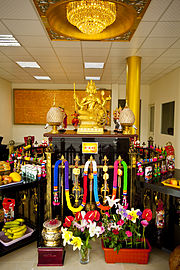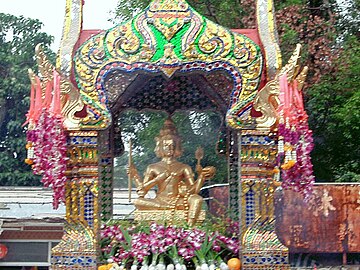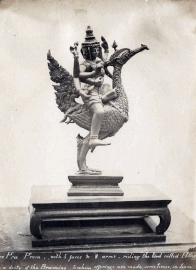Mahabrahma

Mahābrahmā (Tibetan: tshangs pa chen po; Chinese/Japanese: 大梵天 Daibonten; Sinhala: මහා බ්රහ්ම; Thai: มหาพรหฺมฺา), sometimes only called Brahma, is the ruler of the Brahma World (Brahmaloka) in the Buddhist cosmology. He is considered the protector of Buddhist teachings (Pali: Dhammapala; Sanskrit: Dharmapala). Mahabrahma is generally represented in Buddhist culture as a god with four faces and four arms like other Brahmas, and variants of him are found in different Buddhist cultures.[1] The Mahābrahmā, or the Great Brahma, is mentioned in Digha Nikaya as the being who dwells in the upper heaven; a Buddhist student can join him for one kalpa (eon, Brahma-year in Buddhism) after successfully entering the first jhana in the form realm of Buddhist practice.[2]
In many Buddhist Suttas/Sutras, Mahabrahma pays visit to the Buddha. In the 13th-century version of Journey to the West, Sun Wukong's precursor flies Tang Sanzang and his retinue to heaven to meet Mahabrahma, where the monk impresses the devas with his lecture on the Lotus Sutra.[3]
| Part of a series on |
| Buddhism |
|---|
 |
Mahabrahma with other notable brahmas are revered by Buddhists around the world. One can find statues of Mahabrahma in many Buddhist temples. Various temples like Erawan Shrine in Thailand are dedicated to Mahabrahma.
Misconstrued as the Creator of the world
Buddhism is a religion which does not include the belief in a creator deity, or any eternal divine personal being.[4][5][6] Buddhism assumes that the universe has no ultimate beginning to it, and thus sees no need for a creator God. Buddhist texts posits that deities such as Mahabrahma are misconstrued to be a creator.[7] During the Vivartakalpa, a deity from Abhassara plane was reborn in the Mahabrahma plane, as many living beings forget about their past life, this too happened with the Mahabrahma, and being unaware of the above planes of existence, he felt alone. He longed for the presence of others. After some time, many other deities from the above planes were also reborn in those brahma planes, as his ministers and companions.[8] Seeing this happen, he falsely believed himself to be their creator. This belief, states the Buddhist texts, was then shared by other deities. Eventually, however one of the deities died and was reborn as a human. Through meditation, he got the power to remember his previous life.[7] He went on to teach what he remembered from his previous life in the lower heaven, that Mahabrahma was the creator of the universe. This teaching led to the widespread human belief in a creator god, according to the Pali Canon.[7]
Cult of Phra Phrom
Mahabrahma is called Phra Phrom (Thai: พระพรหม; from Sanskrit/Pali: Brahmā, ब्रह्मा) in Thailand. In Thai culture, he is regarded as the deity of good fortune and protection. As early as the 1980s, the popularity of the Erawan cult of Phra Phrom from its inceptions in Thailand spread, accompanied by faithful reproduction of the structure of the shrine and the image, among overseas Buddhists in other countries of Southeast Asia (Singapore, Indonesia and Malaysia), in Taiwan, and in China. A statue of Phra Phrom can also be found on the ground of the Government House of Thailand.
Gallery
- An altar dedicated to Mahabrahma in Kaohsiung, Taiwan.
- Mahabrahma statue at the Erawan Shrine, Bangkok
- Statue of Mahabrahma in a Laotian Buddhist temple.
- Mahabrahma statue in Wat Phothivihan, Kelantan, Malaysia.
- Brahma riding the Hong bird, old statue.
See also
References
- ^ Buswell, Robert E. Jr.; Lopez, Donald S. Jr. (2013-11-24). The Princeton Dictionary of Buddhism. Princeton University Press. ISBN 978-1-4008-4805-8.
- ^ Harvey, Peter (2013). An Introduction to Buddhism: Teachings, History and Practices. Cambridge University Press. ISBN 978-0-521-85942-4.
- ^ Wivell, Charles (1994). "The Story of How the Monk Tripitaka of the Great Country of T'ang Brought Back the Sūtras". In Mair, Victor (ed.). The Columbia Anthology of Traditional Chinese Literature. Columbia University Press. pp. 1181–1207. ISBN 0231074298.
- ^ Harvey, Peter (2019). "Buddhism and Monotheism", p. 1. Cambridge University Press.
- ^ Taliaferro, Charles, ed. (2013), The Routledge Companion to Theism, New York: Routledge, p. 35, ISBN 978-0-415-88164-7
- ^ Blackburn, Anne M.; Samuels, Jeffrey (2003). "II. Denial of God in Buddhism and the Reasons Behind It". Approaching the Dhamma: Buddhist Texts and Practices in South and Southeast Asia. Pariyatti. pp. 128–146. ISBN 978-1-928706-19-9.
- ^ a b c Harvey 2013, p. 36-8.
- ^ Harvey 2013, p. 36-37.










